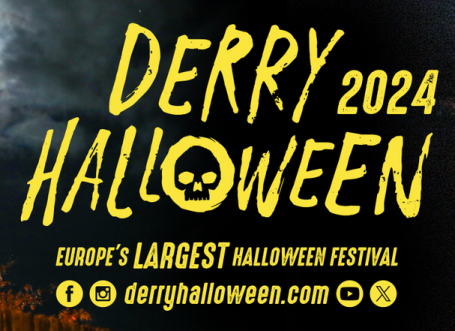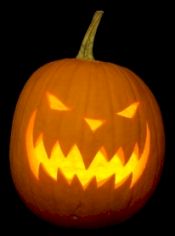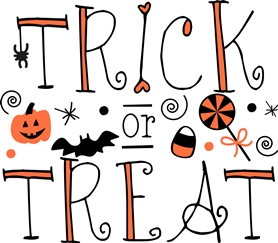- Home ›
- Halloween
Is Halloween
Irish? You bet it is!
The
dark side of Halloween
The origins of Halloween date back to Celtic Ireland and the festival of Samhain.

Samhain had three distinct elements. Firstly, it was an important fire festival, celebrated over the evening of 31 October and throughout the following day. The flames of old fires had to be extinguished and ceremonially re-lit by druids.
It was also a festival not unlike the modern New Year's Day in that it carried the notion of casting out the old and moving into the new.
To our pagan ancestors it marked the end of the pastoral cycle – a time when all the crops would have been gathered and placed in storage for the long winter ahead and when livestock would be brought in from the fields and selected for slaughter or breeding.
But it was also, as the last day of the year, the time when the souls of the departed would return to their former homes and when potentially malevolent spirits were released from the Otherworld and were visible to mankind.
Samhain: its place in the Celtic calendar
The Celts celebrated four major festivals each year. None of them was connected in anyway to the sun's cycle.
The origin of Halloween lies in the Celt's Autumn festival which was held on the first day of the 11th month, the month known as November in English but as Samhain in Irish.
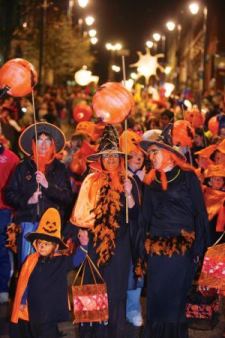
The festivals are known by other names in other Celtic countries but there is usually some similarity, if only in the translation.
In Scottish Gaelic, the autumn festival is called Samhuinn. In Manx it is Sauin.
The root of the word – sam – means summer, while fuin means end. And this signals the idea of a seasonal change rather than a notion of worship or ritual.
The original Celtic year
- Imbolc: 1st February
- Beltaine: 1st May
- Lughnasa: 1st August
- Samhain: 1st November
See Celtic Holidays page
The Celts believed that the passage of a day began with darkness and progressed into the light. The same notion explains why Winter – the season of long, dark nights – marked the beginning of the year and progressed into the lighter days of Spring, Summer and Autumn.
So the 1st of November, Samhain, was the Celtic New Year, and the celebrations began at sunset of the day before - its 'Eve'.

Samhain had three distinct elements. Firstly, it was an important fire festival, celebrated over the evening of 31 October and throughout the following day. The flames of old fires had to be extinguished and ceremonially re-lit by druids.
It was also a festival not unlike the modern New Year's Day in that it carried the notion of casting out the old and moving into the new.
To our pagan ancestors it marked the end of the pastoral cycle – a time when all the crops would have been gathered and placed in storage for the long winter ahead and when livestock would be brought in from the fields and selected for slaughter or breeding.
But it was also, as the last day of the year, the time when the souls of the departed would return to their former homes and when potentially malevolent spirits were released from the Otherworld and were visible to mankind.
Samhain: its place in the Celtic calendar
The Celts celebrated four major festivals each year. None of them was connected in anyway to the sun's cycle.
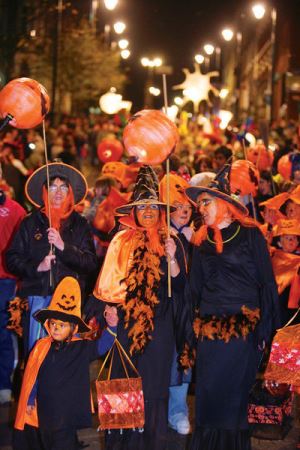 Derry's Halloween Carnival takes place along the banks of the River Foyle
Derry's Halloween Carnival takes place along the banks of the River FoyleThe origin of Halloween lies in the Celt's Autumn festival which was held on the first day of the 11th month - the month known as November in English but as Samhain in Irish.
The festivals are known by other names in other Celtic countries but there is usually some similarity, if only in the translation.
In Scottish Gaelic, the autumn festival is called Samhuinn. In Manx it is Sauin.
The root of the word – sam – means summer, while fuin means end. And this signals the idea of a seasonal change rather than a notion of worship or ritual.
The other group of Celtic languages (known as Q-Celtic) have very different words but a similar intention. In Welsh, the day is Calan Gaeaf, which means the first day of winter. In Brittany, the day is Kala Goanv, which means the beginning of November.
The original Celtic year
- Imbolc: 1st February
- Beltaine: 1st May
- Lughnasa: 1st August
- Samhain: 1st November
See Celtic Holidays page
The Celts believed that the passage of a day began with darkness and progressed into the light. The same notion explains why Winter – the season of long, dark nights – marked the beginning of the year and progressed into the lighter days of Spring, Summer and Autumn.
So the 1st of November, Samhain, was the Celtic New Year, and the celebrations began at sunset of the day before - its 'Eve'.
The Roman Autumn festival
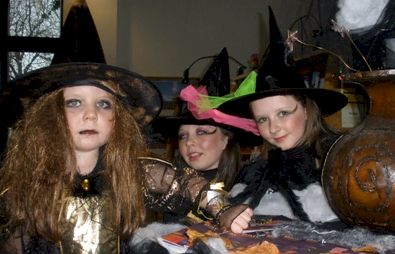 Three young witches prepare for Ireland's biggest Halloween celebrations in Derry.
Three young witches prepare for Ireland's biggest Halloween celebrations in Derry.Harvest was celebrated by the Romans with a festival dedicated to Pomona, the goddess of the fruits of the tree, especially apples. The origin of Halloween's special menus, which usually involve apples (as do many party games), probably dates from this period.
The Roman Autumn festival
Harvest was celebrated by the Romans with a festival dedicated to Pomona, the goddess of the fruits of the tree, especially apples. The origin of Halloween's special menus, which usually involve apples (as do many party games), probably dates from this period.

Pomona continued to be celebrated long after the arrival of Christianity in Roman Europe.
So, too, did Samhain in Ireland and it was inevitable that an alternative would be found to push pagan culture and lore into a more 'acceptable' Christian event.
Sure enough, the 7th-century Pope Boniface, attempting to lead his flock away from pagan celebrations and rituals, declared 1st November to be All Saints Day, also known as All Hallows Day.
The evening before became known as Hallows' Eve, and from there the origin of Halloween, as a word, is clear.
The origin of Halloween's spookiness
For Celts, Samhain was a spiritual time, but with a lot of confusion thrown into the mix.
Being 'between years' or 'in transition', the usually fairly stable boundaries between the Otherworld and the human world became less secure so that puka, banshees, fairies and other spirits could come and go quite freely. There were also 'shape shifters' at large. This is where the dark side of Halloween originated.
Apples
Samhain marked the end of the final harvest of the summer, and all apples had to have been picked by the time the day's feasting began.
It was believed that on Samhain, the puca – Irish evil fairies (see right hand column) – spat on any unharvested apples to make them inedible.
To ward off the evil let loose at Samhain, huge bonfires were lit and people wore ugly masks and disguises to confuse the spirits and stop the dead identifying individuals who they had disliked during their own lifetime.
They also deliberately made a lot of noise to unsettle the spirits and drive them away from their homes. The timid, however, would leave out food in their homes, or at the nearest hawthorn or whitethorn bush (where fairies were known to live), hoping that their generosity would appease the spirits.
Apples
Samhain marked the end of the final harvest of the summer, and all apples had to have been picked by the time the day's feasting began.
It was believed that on Samhain, the puca – Irish evil fairies (see The Little People below) – spat on any unharvested apples to make them inedible.
For some, the tradition of leaving food (and a spoon to eat it!) in the home – usually a plate of champ or Colcannon – was more about offering hospitality to their own ancestors.
Just as spells and incantations of witches were especially powerful at Samhain, so the night was believed to be full of portents of the future.
Ireland's best Halloween party is in Derry
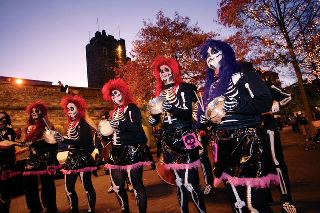
While the origin of Halloween doesn't lie specifically in Derry, Europe's biggest Halloween party is held in the city every year. More than 30,000 people take to the streets, most of them dressed as witches, ghouls, vampires and monsters from the Otherworld.
There's a full programme of events across the four days, including hands-on activities for the little 'uns, live music sessions featuring ghostly and supernatural ballads, visits to the haunted railway museum and the House of Horrors, and much more.
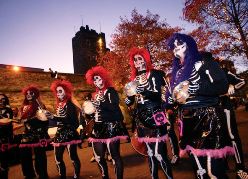
It's a time when you're almost certain to hear the Banshees screaming – assuming you can hear anything much above the marching bands, ceilidh music, hard rock and calypso as a fantastic carnival proceeds through the town, celebrating all things spooky.
The main parade starts on Queen's Quay at 7pm on the 31st, and a spectactular display of pyrotechnics brings celebrations to a close at 8.30pm.
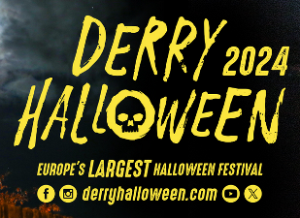
More about the origin of Halloween and its traditions
Free Halloween booklet
The National Folklore Collection, which is hosted by University College Dublin, has published a free booklet for Halloween containing old Irish tales, legends and customs. You can download it (pdf 950Kb) here: Dúchas - Halloween.
The 'Little People'
Celtic tales are full of heroic warriors and mystical gods. They are also the origin of Halloween's (and Ireland's) preoccupation with the 'little people'.
Academics have concluded that the little people were, originally, the pagan gods of Ireland who lost their significance and, metaphorically, their stature, when Christianity arrived.
Despite their reduced state and retirement to the Underworld as fairies, a memory of their magical powers held fast in the imagination of the people. Here lies the origin of Halloween's dark side.
There are two main groups of fairy: the trooping fairies who are, for the most part, friendly and have healing powers, and the solitary fairy who causes mischief and is quick to anger.
Among the specific terrors of Halloween were the Fomorians who believed they had a right to take back to the Otherworld their share of fresh milk, grains and live children.
The Leprechaun is the best known of the latter group. Find out more about the diminutive shoemakers.
The fairy most connected with the origin of Halloween is the Puca (pronounced Pooka) who is decidedly malevolent and capable of assuming any shape. The puca is particularly adept at taking animal shapes, especially horses, so riders beware on Halloween – your 'steed' may not be under your control!
The Banshee is another fairy, always female, who warns of approaching death by letting loose a terrible, eerie wail (the Banshee scream) that is guaranteed to send a shiver down the spine of those that hear it. If you hear the cry of the Banshee of Ireland, you should look out for a funeral carriage pulled by a headless horse.
